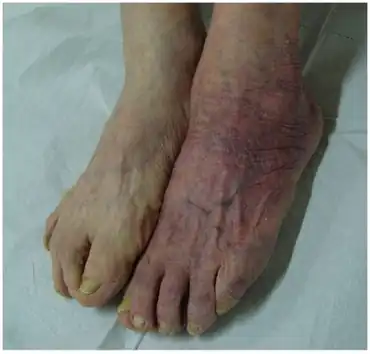Acrodermatitis chronica atrophicans
| Acrodermatitis chronica atrophicans | |
|---|---|
| Other names: Primary diffuse atrophy,[1] Herxheimer disease,[2]: 1102 | |
 | |
| Acrodermatitis chronica atrophicans | |
| Specialty | Dermatology |
| Symptoms | Bluish-red discolouration, thinning skin.[1] |
| Usual onset | Elderly in Europe[1] |
| Duration | Slowly progressive[1] |
| Causes | Mostly Borrelia afzelii[1] |
| Treatment | Antibiotics[1] |
| Medication | Doxycycline, amoxicillin, ceftriaxone, cefotaxime, penicillin G[3] |
| Prognosis | Good if treated in early stage[3] |
| Frequency | Females>males, ~10% of cases of Lyme disease in Europe[3] |
Acrodermatitis chronica atrophicans (ACA) is an ongoing infection of the skin that occurs in the late stage of Lyme disease.[1] It typically presents in females aged 60-years to 70-years, with bluish-red discolouration of the backs of hands and feet which spreads up the arms and legs.[3] The skin may appear slightly scaly or swollen, and underlying small blood vessels are generally easily seen.[1] After some weeks to months, it progresses to a "crumpled cigarette paper" appearance; thin, velvety wrinkled skin.[1] Painless firm small bumps just under the skin may form, particularly over the wrists, elbows and knees.[1] Complications include polyneuropathy, osteoarthritis, and skin cancer.[1][3]
It is most frequently caused by Borrelia afzelii.[3] European B. burgdorferi sensu stricto and B. garinii are less common causes.[3] Treatment is with 14-days to 28-days of antibiotics; these may include doxycycline 100 mg twice daily or 200 mg once daily by mouth, or 500mg to 1000 mg amoxicillin three times daily by mouth.[3][4] Alternatively, antibiotics may be given intravenously; either ceftriaxone 2000 mg once daily, or cefotaxime 2000 mg four times daily, or penicillin G 3 to 4 MU eight times daily.[3]
Females are affected more frequently than males.[3] It occurs in around 10% of cases of Lyme disease in Europe.[3] German physician Alfred Buchwald first described the condition in 1883.[3]
Signs and symptoms
It typically presents with bluish-red discolouration of the backs of hands and feet which spreads up the arms and legs, and progresses to thinning of the skin.[3] The skin may appear slightly scaly or swollen, and underlying small blood vessels are generally easily seen.[1] After some weeks to months, it develops to a "crumpled cigarette paper" appearance; thin, velvety wrinkled skin.[1] Painless firm small bumps just under the skin may form, particularly over the wrists, elbows and knees.[1]
Cause
It is most frequently caused by Borrelia afzelii.[3] European B. burgdorferi sensu stricto and B. garinii are less common causes.[3]
Diagnosis
Diagnosis is by serologic and histologic examination.
Generally a two-step approach is followed. First, a screening test involving IgM and IgG ELISA. If the first screening has a positive result, or there is a high clinical suspicion in spite of Elisa being negative, then the second step is to perform a Western Blot as a confirmatory test.
Other methods include microscopy and culture (in modified Kelly's medium) of skin biopsy or blood samples.
Treatment
Treatment is with 14-days to 28-days of antibiotics; these may include doxycycline 100 mg twice daily or 200 mg once daily by mouth, or 500mg to 1000 mg amoxicillin three times daily by mouth.[3] Alternatively, antibiotics may be given intravenously; either ceftriaxone 2000 mg once daily, or cefotaxime 2000 mg four times daily, or penicillin G 3 to 4 MU eight times daily.[3]
In the UK, first line treatment of ACA with doxycycline costs the NHS around £20 for 28-days.[4] Intravenous ceftriaxone may be used if both doxycycline and amoxicillin are unsuitable.[4]
History
German physician Alfred Buchwald first described the condition in 1883.[3] Herxheimer and Hartmann described it in 1902 as a "tissue paper like" cutaneous atrophy.
See also
References
- 1 2 3 4 5 6 7 8 9 10 11 12 13 14 James, William D.; Elston, Dirk; Treat, James R.; Rosenbach, Misha A.; Neuhaus, Isaac (2020). "14. Bacterial infections". Andrews' Diseases of the Skin: Clinical Dermatology (13th ed.). Edinburgh: Elsevier. p. 288. ISBN 978-0-323-54753-6. Archived from the original on 2023-03-26. Retrieved 2023-03-26.
- ↑ Rapini, Ronald P.; Bolognia, Jean L.; Jorizzo, Joseph L. (2007). Dermatology: 2-Volume Set. St. Louis: Mosby. ISBN 978-1-4160-2999-1.
- 1 2 3 4 5 6 7 8 9 10 11 12 13 14 15 16 17 18 Gade, Anita; Matin, Taraneh; Rubenstein, Richard; Robinson, Carolyn A. (2023). "Acrodermatitis Chronica Atrophicans". StatPearls. StatPearls Publishing. Archived from the original on 2022-03-03. Retrieved 2022-03-03.
- 1 2 3 "5. Infection". BNF (84 ed.). London: BMJ Group and the Pharmaceutical Press. September 2022 – March 2023. pp. 616–630. ISBN 978-0-85711-432-7.
{{cite book}}: CS1 maint: date format (link)
External links
| Classification | |
|---|---|
| External resources |